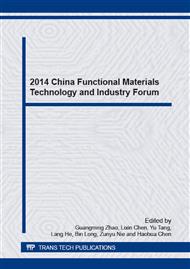p.136
p.140
p.144
p.155
p.161
p.169
p.175
p.180
p.187
Synthesis and Properties of Nano-TiO2 Modified Fluorine-Containing Polyacrylate Soap-Free Emulsion
Abstract:
Nano-TiO2 Modified Fluorine-Containing Polyacrylate Soap-Free Emulsion was Successfully Synthesized via Soap-Free Emulsion Polymerization Technique, in which the Polymerization Monomers Consisted of Methyl Methacrylate (MMA), Butyl Acrylate (BA) and Dodecafluoroheptyl Methacrylate (DFMA). the Influence of Amount of Initiator, Emulsifier, Containing Fluorine Monomer and nano-TiO2 on the Performance of Emulsion was Investigated. the Results Showed that the Good Polymerization Stability, and High Monomer Conversion were Obtained when the Amount of Ammonium Initiator was 1.2%, the Amount of Reactive Emulsifier was 3.5%. with Increasing Amount of DFMA, the Monomer Conversion Decreased and the Gel Rate Increased Gradually with the Increase of DFMA Amount. UV-Blocking Ability of the Cotton Fabric Treated with the Hybrid Emulsion Containing Nano-Tio2 increased with Increasing Amount of Nano-TiO2. IR Spectrum Results Showed that Nano-TiO2 and Fluorine-Containing Monomer were Successfully Introduced in the Segmental Structure of the Polymer. SEM Revealed that Nano-TiO2 was Loaded on the Surface of the Treated Cotton Fabric which had Good Hydrophobicity.
Info:
Periodical:
Pages:
161-168
Citation:
Online since:
December 2014
Authors:
Keywords:
Price:
Сopyright:
© 2015 Trans Tech Publications Ltd. All Rights Reserved
Share:
Citation:


